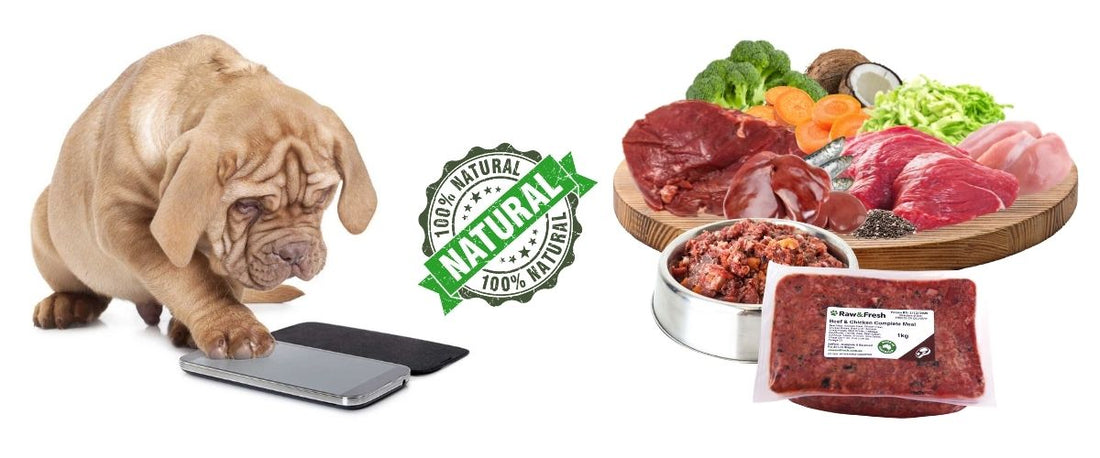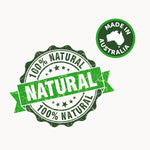
How Much Should I Feed My Puppy?
Reading time: 5 minutes.
If you're reading this, you've made a new best friend and you want to feed your puppy a high quality diet. You believe they deserve the best. We'll help you choose a diet that you can confidently feed your dogs for the rest of their lives.
We'll explain why we don't recommend processed food and why we believe a natural raw diet is best for your dog. It's important to fuel your growing puppies in the best way possible!
We're here to help with giving the best advice on providing raw food for puppies as they develop and grow. We believe in giving our loved ones the best nutrients and a complete and balanced meal plan.
- Why feed raw?
- Transition to raw food
- Start with a single protein source
- Balanced nutrition
- Safe bone content
- How much to feed your puppy and how often
- Puppy feeding chart
- Getting started

Why Feed Raw Food To Your Puppy?
Raw feeding is sometimes referred to as a BARF (Biologically Appropriate Raw Food) diet. The basic principle is that animals will live healthier lives if they eat foods their ancestors ate in the wild. It seems perfectly logical, but for some reason, the vast majority of pet foods on the market don't follow this principle.
Domestic dogs are primarily scavengers who will digest nutrients from a mix of meat and vegetable sources. Dogs prefer offal and organ meats when given the choice, for their higher levels of vitamins and minerals.
Benefits of a BARF diet include:
- Higher nutritional value
- More digestible
- Free of preservatives and additives
- Higher in natural vitamin and mineral content
We also have many reports from our happy customers of:
- Improved energy levels
- Shinier coat
- Reduced sensitivity to skin conditions and allergies
- More regular bowel function
- Less fussy eating
What's Wrong with Dry Food?
Most commercial dry foods (even the ones recommended by your vet) are high in grains, fillers, and preservatives. These food sources aren't suitable as the primary energy source for dogs. Many dry foods are irradiated to kill pathogens. A process that changes the nutrient profile and has been linked to neurological issues in pets.
Tinned wet food is highly processed and cooked at very high temperatures, destroying many of the natural nutrients in the food. They also tend to be high in sodium and fats derived from low-quality sources.
The fillers and artificial ingredients in processed foods also cause various allergies and ailments. The evidence of which only shows up later in life, after a long history of malnourishment.
Premium raw dog food is highly digestible and free from additives or chemicals. It can provide a complete and balanced diet for every life stage.
Transition to Raw Food
At 4 weeks of age, a puppy is ready to progress from their mother's milk to more solid food. Ideally, you would not be adopting a puppy before 8 weeks of age, so we recommend your breeder should manage the introduction of solid foods before you feed a Raw & Fresh diet from 8 weeks of age or older. Many breeders will already be feeding their dogs a raw diet before you take your puppy home.
It's best to transition your puppy to a raw diet as soon as their digestive system will allow. You can expect some soft poo as they adjust to the new diet. Provided they're otherwise in good spirits, this should pass in a few days.
If you're already feeding kibble, then you should transition to raw feeding gradually over the period of 2-3 weeks. Individual puppies will adapt differently. Some will adjust quickly, while breeds or dogs with more sensitive digestive systems will need to change more gradually. Kibble digests differently to raw food, so keep a close eye on how they react to the change and slow down your transition if you notice some upset.
If your puppy has diarrhea for three or more days, you should either try cooking your raw food or switch to a food that you know agrees with them. You can reintroduce another protein source to get an idea of what's upsetting them. If they show further signs of ill health, such as refusal to eat or lethargy, seek the advice of your vet.
Start with a Single, Consistent Meal Plan
When you first start feeding puppy food, it's better to stay consistent with your meals for the first 2-3 weeks. This ensures they take to the diet properly and helps you find sensitivities if they exist. If they adjust to this diet without digestive upset, you're ready to offer other protein sources for variety, if you choose.
Balanced Nutrition
To support their growing bodies and immune systems, we should feed meals that give puppies complete and balanced nutrition. This is especially important for a large breed puppy, who will have special needs to build strong bones as they grow. Too much calcium is problematic, as well as too little.

So, what should I feed my puppy?
For a healthy, growing puppy, we recommend our Raw & Fresh Complete Beef Recipe. This recipe is complete and balanced for all life stages, including for large breeds. It has been specially formulated to exceed the requirements of the AAFCO food guidelines. You can read more on the Complete Beef product page.
Puppies will eat similar raw ingredients to adult dog food. However, the nutrient ratios will change with their requirements as they grow.
Raw & Fresh Beef Complete for Puppies
Safe Bone Content
On the subject of bones, it's important to consider the safety of any bone content you feed to a small puppy. The size of the bones should always be appropriate for them to chew safely, without swallowing pieces too big for them.
Our Complete Beef recipe already contains the recommended daily bone content and calcium for all life stages, but you may also want to feed bones separately, if you feed alternately with our other recipes.
In a minced recipe, the bones should be so finely ground that they can eat them mixed in with their normal meals. Otherwise, they should be big enough that they only shave off small pieces as they work their jaws. You should be especially careful with small breeds or greedy eaters for choking hazards.
In order of increasing size, you can feed chicken necks, turkey necks or lamb bones. Smaller, finely-chopped bones can be fed daily, while chewing bones should be given no more than twice per week. Just be careful to always supervise chewing and feed less if they become constipated.

How Much to Feed Your Puppy and How Often?
Puppies eat almost the same amount of food as adult dogs during their rapid growth stage. They burn energy faster than adults, yet have smaller tummies. You'll need to feed your puppy several times a day in smaller portions.
Follow the standard total daily calculation, but split that total into multiple meals. As far as how often to feed a puppy, feeding 3-4 meals per day is ideal.
It's important to follow a steady routine for your puppy's feeding schedule. Giving them consistency will help with training, reduce begging and make them less fussy. The best puppy treats for training are natural, unprocessed treats like beef jerky or dog liver treats.
Puppy Feeding Chart
This chart helps calculate the daily amount of raw food required for a growing puppy. The amounts calculated are per day.
The total daily feeding recommendation should be balanced between the nutrients mentioned above. Splitting the total daily requirement into smaller meals aids your puppy's digestion and prevents bloat.
You should regularly check your puppy's weight and activity levels to maintain good balance between weight maintenance and growth. For a large breed dog, you have a little more leeway to adjust amounts based on activity.
Depending on their age, you will feed a percentage of their total current body weight per day in kg. For example:
If you have a 9-week old puppy who weighs 8kg, you would calculate:
- at this age, we feed 10% of current total body weight per day
- times 8 kg
- 0.1 x 8 = 0.8 kg per day
- or 800 grams per day
| Age | % of body weight | Calculation |
| 8-10 weeks | 10% | 0.1 x body weight |
| 10-16 weeks | 8% | 0.08 x body weight |
| 16-20 weeks | 7% | 0.07 x body weight |
| 20-24 weeks | 6% | 0.06 x body weight |
| 24-36 weeks | 5% | 0.05 x body weight |
| 36-56 weeks | 4% | 0.04 x body weight |
| 56-68 weeks | 3% | 0.03 x body weight |
| 68 weeks + | 2-4%* | 0.02-0.04 x body weight |
* depending on exercise
We also have a more detailed raw feeding guide for adult dogs, for when your puppy grows up.
Getting Started
With this information in mind, you're ready to start your new puppy on a healthy meal plan. We've perfected our recipes over many years of feeding and five years of production. We have thousands of healthy, happy customers.
Our range of raw puppy food options has you covered.
If you have any questions, email us at theden@rawandfresh.com.au or use live chat on Facebook Messenger below. We're always happy to help you choose the best diet plan for your puppy.
You can also read our many positive reviews from happy customers on our Facebook page.
As with any feeding routine, keep a close eye on your pup for signs of allergies or digestive sensitivity. Seek the advice of your vet if you suspect an issue.
Good luck with your new health journey. We're here to help along the way!

